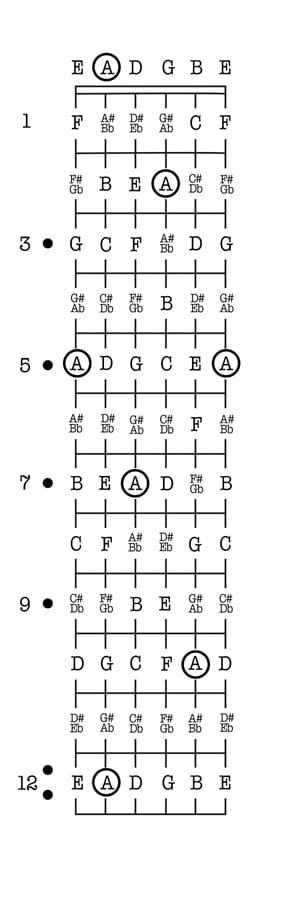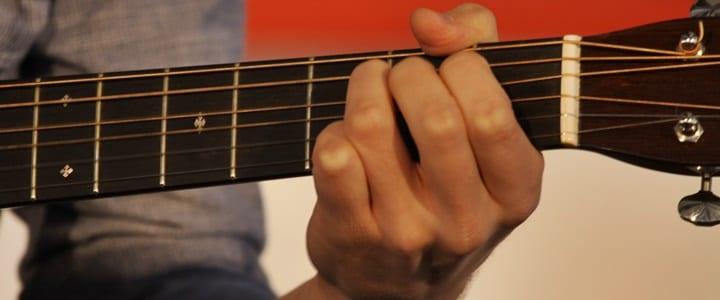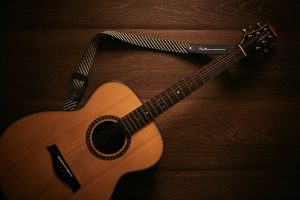Looking for help with guitar notes? You’ve come to the right place. Whether you want to learn to improvise jaw-dropping solos, play brilliant classical etudes, or anything in between, learning where to find notes on a guitar is a vital step in your musical journey.
In this ultimate guide, we’ll share everything you need to know about what notes are guitar strings and intervals.
What Are All Notes on Guitar?
What notes are the 6 strings on a guitar? Each string on a guitar corresponds with its own individual note.
Therefore, the 6 notes on guitar strings are:
- E
- A
- D
- G
- B
- E
It’s not quite as simple as that, though, since there are also sharps and flats. These are half-steps away from the natural notes. Because of this, all A on guitar might not just be the classic A on guitar note, but also A sharp and A flat. All notes have sharps and flats between them except BC and EF. A half-step between these leads to the next natural note (with no sharp or flat).
Mastering these music notes for guitar and strings can be challenging, but fortunately, there are all kinds of mnemonic devices and other strategies you can use to get the hang of them.
Guitar Notes: The Ultimate Guide
Now that you know how many notes on a guitar you need to master, let’s break things down a bit more. How do guitar notes work, and what are some easy ways to master them? Let’s dive in!
How Do Notes on a Guitar Work?
Understanding the basic mechanics and parts of a guitar is necessary to learn how to play guitar notes.
In simple terms, a guitar works by disrupting air around the strings, creating a vibration. That vibration is then amplified by the hollow chamber of the guitar and the guitar bridge to create the sounds you hear.
The speed and depth of the string’s vibration influences the pitch of the sound that comes from the guitar.
Electric guitars work in a similar fashion, but instead of the sound vibrating through a hollow chamber, the sounds of the strings vibrating against the bridge are amplified by an outside speaker. Electric guitars, on their own, are very quiet.
The strings don’t produce much noise unless an amp is attached, because the sound of the string has no hollow chamber to travel into.
What Does Every Note on a Guitar Do?
A traditional guitar has six strings and each string is responsible for a different note. The string’s width influences the amount of vibration that’s produced by the string, which influences the sound of each note.
The length of the string also comes into play. You may notice that a mandolin, for example, has a higher pitch than a traditional acoustic guitar. This is because the strings are shorter, and thus the sound needs less time to travel.
Frets, which will be covered in-depth below, can help you change the pitch of a note, or change the note of a string to a completely different one.
Notes on a guitar are both fluid and concrete. An open string on a well-tuned guitar will always be the same note, but pressing the frets down to alter the distance between the string and the bridge can completely change the resulting sound.
What Are the Notes on a Guitar?
The notes on a guitar are created by the strings of the guitar.
When holding a guitar, the thickest string, the E string, is at the top of the guitar. The E note is the deepest note.
The rest of the strings get progressively thinner and the notes get higher in pitch. They’re responsible for the A, D, G, B and E notes, respectively.
The thinnest string, which is situated at the bottom of the guitar when you’re holding it, is responsible for the E note, which is two octaves up from the low E note.
As you may note on your guitar, there are also marks along the neck of guitar. These markers indicate the different frets on the guitar. Your guitar may have anywhere between 16 and 24 frets.
When you strum a string without pressing down on a fret, it’s known as an open chord. Each fret represents one half-step of the musical scale.
In order to play a higher pitch note, regardless of the string you’re playing, your hands would be placed on a fret closer to the bridge of the guitar. If you’re fretting at the second fret marker on the guitar, the low E turns into an F sharp, which is often denoted as F#.
Focusing on the low E string, holding down the first fret will produce an F, while holding down the second fret will produce an F#; the third fret will produce a G note on guitar and the fourth, a G#. The seventh fret on the low E string will produce the B note, while the eighth fret will produce the C note.
This process can be replicated on each of the remaining five strings.
How to Learn Guitar Notes
For the novice guitar player, the above information may seem complicated. Remember: rock stars, professional session players, and even music teachers started at the same place you are now.
The good news, however, is that if you can master guitar notes and gain an in-depth understanding of how they work, you’re well on your way to truly understanding music theory and being able to play the songs you hear on the radio on your guitar. So now you’re probably wondering about the best ways to learn guitar notes. Here are some of the best options.
Private Lessons
Learning to play an instrument isn’t easy, especially for individuals who have never picked up the instrument before. The guitar, in particular, can seem confusing, but really is a straightforward instrument to play. Once a student understands the basics, it’s perhaps the most enjoyable instrument out there.
To learn the basics, including the anatomy of a guitar, students would be best served learning from a private instructor. A private instructor can offer the guidance and explanation needed for students to truly understand the structure of the guitar.
This is an important framework for understanding how notes on a guitar work, and how they work together to create chords, chord progressions, and eventually songs.
Guitar String Mnemonic Devices
To start learning guitar notes, you’ll need to memorize them so you will always know what notes are being played.
To do this, you can take yourself back in time to when you were first in grammar school. At some point you probably used mnemonic devices to remember grammar rules or the planets in the solar system.
Simply put, a mnemonic device is a technique that helps you remember something by attaching a rhyming scheme to it, or a phrase.
When it comes to the notes on a guitar, the strings progress as E, A, D, G, B, E. Several professional musicians use the mnemonic device, “Eddie ate dynamite, good-bye Eddie.”
Mnemonic devices can help you remember the names of each note, but for this to be truly helpful, you’ll need to memorize them with the guitar in front of you.
Playing each note while reciting it out loud is perhaps the best way to learn the basics. Experts suggest starting with open notes. An open note, as you know, is simply the act of strumming a string without fretting.
Memorizing Intervals
 The guitar strings notes are tuned in intervals of fourths, starting from the lowest note on guitar.
The guitar strings notes are tuned in intervals of fourths, starting from the lowest note on guitar.
That means that the next higher string is 5 half-steps above the previous string. This is true for all sets of strings except for the relationship between the third and second string, which is a third interval (4 half-steps) instead of a fourth interval.
Start by identifying and memorizing all interval fingerings within an octave that are in a practical position to play on the guitar.
For example, looking at the chart to the left, find all the As. You can play A on the fifth fret of the E string, on the open A string, the seventh fret of the D string, the second fret of the G string, and so on.
When you reach the fingering of a fifth interval, you’ll have three practical shape options:
- Same string / 7 frets up
- Next higher string / 2 frets up
- Skip a string / 3 frets down
Keep in mind to compensate for the third interval tuning between the third and second strings whenever you use or cross over the second string.
Once you feel comfortable with visualizing all possible fingerings within an octave, it’s time to explore these same intervals but in reverse. This time around, let’s start with the first note on the first string and work ourselves down in pitch using the same interval fingerings but in reverse. Remember to stick to practical fingerings that you can incorporate into your playing.
The next step would be to explore interval fingerings that are larger than an octave. You can use the next higher or lower octave note as an anchor point to help you visualize where you need to go.
This alone will take lots of patient practicing and visualizing. If you’re a visual learner, looking at a guitar fretboard chart – like the one pictured – can really help. You can use this chart to practice even when you don’t have a guitar around.
Practice
It may sound cliché, but now that you have a basic understanding of the notes on guitar strings and how they all work in conjunction together, the best step to mastering these very basic concepts is to practice.
Experts suggest looking at the notes and playing each one so you can gain a better understanding of how each note sounds. Experts also suggest completing note exercises with an electric tuner attached to the guitar. A tuner is a small device that connects to the neck of the guitar and measures the tone of each note.
Mostly used to help players tune their guitar, it’s a great learning tool too. It can help you understand how each note should sound when the guitar is correctly tuned, and it’ll further help you understand how all notes on guitar are connected to the strings that are being strummed. More on this later!
Other Tips for Understanding Notes on a Guitar
We’re not done yet! Here are a few more notes of guitar strings for getting the hang of notes on a guitar.
How to Hammer a Note on the Guitar
A hammer, also known as a hammer-on, is a technique that just about every guitar player will utilize to improve their playing speed. Knowing how to hammer a note on the guitar is important to allow you to play multiple notes without having to change your speed or your picking rhythm.
To do this, you will simply hit the string with your fretting hand, pressing down quickly to soothe note rings without having to strum.
Adjust the power – that way, the picked and hammered note will have the same volume. If you over-hit it, the note will go sharp and sound out of pitch.
You can add hammer-ons anywhere across the neck to increase your playing speed. They can come after notes can roll down two or three notes at once, and even be combined with pull-offs later on!
One final note – although you can use any finger to hammer on, it’s usually easiest to learn with the index and ring fingers.
How to Sustain a Note on Guitar
Playing a sustained note on the guitar can be challenging.
There are a few ways you can do this. One is to consider the type of guitar you are using, since not all models of guitars will have the same ability to sustain. You can also use a compressor or sustainer pedal to add that effect.
Distortion can help you sustain a note and compress the tone, too.
Even something as simple as cleaning your guitar can help you better sustain a note since grime and dirt on frets and strings can make it more difficult for the string to vibrate.
If that doesn’t work, try putting on a new set of strings. The old ones might be worn down and make it harder for you to hit the notes on a guitar that you want to.
Tuning Notes on a Guitar
Tuning notes on a guitar is a key part of becoming a good guitar player.
Standard tuning starts with the thickest, lowest-pitched string, the sixth string. You’ll worm the top of the neck, tuning E- A- D- G- B- E. When you tune, pluck the string a lot to give you an idea of what needs to be adjusted.
Although home guitar players can tune by ear, many rely on a tuner to help them adjust their instruments. Pluck the string close to the device so the mic picks up the sound, then turn the pegs on the guitar until the arrow lines up with the correct notes on a guitar (the tuner may even turn green).
If the string is too flat, meaning it is too low in pitch, you can turn the tuning peg to tighten the strings. If it’s too sharp, you can turn the tuning peg to loosen the strings.
Still confused? Here’s a quick video to help break things down for you.
How Do You Memorize Notes on a Guitar?
Memorizing notes on a guitar isn’t challenging once you know what to look for and what the notes actually are. It shouldn’t take you long, especially when you rely on strategies like using mnemonic devices or taking guitar lessons online.
Remember to have fun when practicing guitar notes! When you step out of a private lesson, you shouldn’t just put your guitar away until the next week. Instead, go home and have fun with what you learned.
Try out different guitar notes, follow along to your favorite songs, and try to work out the notes that are most commonly used in your favorite music. This will not only give you a deeper appreciation for the art of playing guitar, but it’ll make your practice a fun experience.
Photos by Eli Christman, poppy
Megan L.







